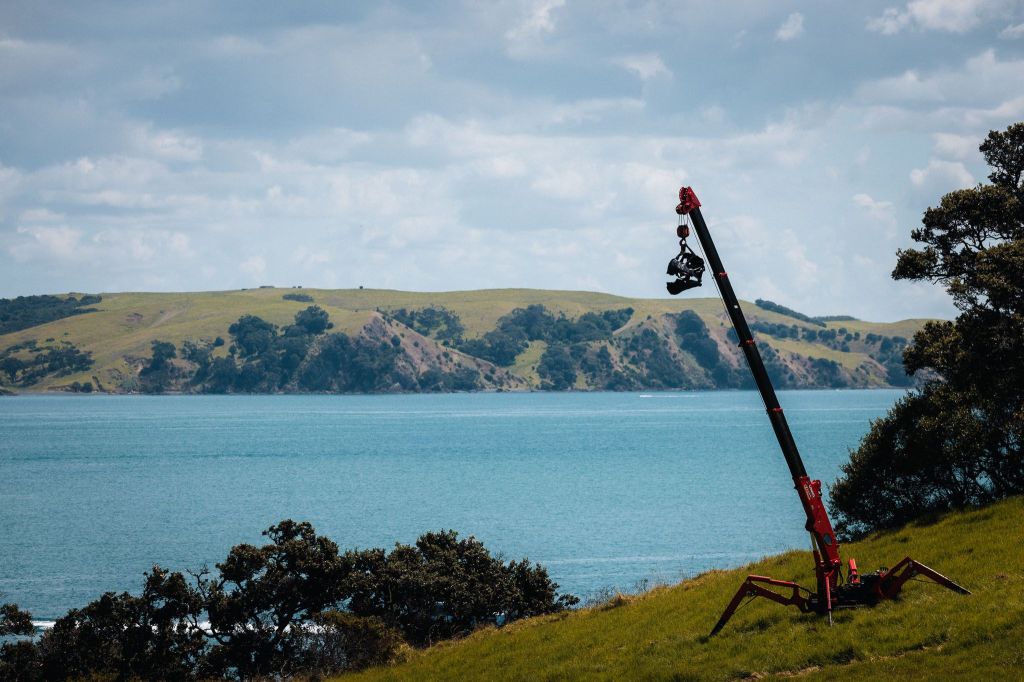Reviewed by John Daly-Peoples

Sculpture on the Gulf
Waiheke Island
Until April 1
Reviewed by John Daly-Peoples
A few years ago Waiheke’s Sculpture on the Gulf was included in the New York Times top things to do and the event is regarded by many as one of the great outdoor sculpture exhibitions, not just for the standard of the sculpture but also for the experience of the two kilometre walk with a backdrop of bush, hills, sea and headlands as well as panoramic views of distant Auckland and the islands of the gulf.
The event attracts tens of thousands of people for the five week show which features over twenty-one works, down from the twenty-seven of the last show two years ago.
There is a bit of a surprise mid-way through sculpture walk seeing Jorge Wright’s monumental Corten steel work “Head Within” standing only a few metres from where it was two years. It was bought by the owner of the property which abuts the sculpture walk.
Many of the works in this years exhibition have strong architectural and historical connections, reflecting on the changing built environment and the congruent changes to the natural environment.

Turumeke Harrington slices of native trees in “Stumped I-XII” reference the trees which once covered Tamaki Makura while Chevron Hassett’s “Te Kupenga” welcoming entranceway with its 19th century fretwork would have been built with that cut timber.

There is Ana Iti’s “Whakaruruhau”, a deconstructed work of structural elements which is also similar to the more elaborate work of Lonnie Hutchinson’s “Moemoea – A model for Dreaming” where her designs in turn relate to Chevron Hassett’s “Te Kupenga”.
Yona Lee’s “Fountain in Transit” uses the steel tubing she often uses to construct interior space with her to create a shower nestled in the bush.

Oliver Stretton-Pow’s marooned lighthouse “Hard Graft” links architecture to plant growth, timber and the tendrils of ocean creatures, referencing the country’s maritime history.
There are references to international architecture and art with Natalie Guy’s “The Staircase” a homage to Carla Scarpa’s innovative use of materials and designs. Another reference to international art can be seen in Seung Yul Oh’s “Cycloid I, II, III, IV, V, and VI” which mimic Alexander Calder’s lively and colourful shapes . Here the works are like abstract bushes growing alongside the path.

There is an architectural component to Nicholas Galanin’s “An Unmarked Grave Deep Enough to Bury Colony and Empire” which uses the outline of Queen Victorias statue as a template for the grave he has dug on the headland.
The most powerful of the architectural works is Brett Graham’s “Wakefield Dreaming” which dominates the headland with his references to the justice system and the overreach of surveillance
Gavin Hipkins’ “Hotel Flag” evolved from the nautical flag representing the letter H, the first letter of the artists name, it also references the abstract geometric art of Malevich or Stephen Bambury.
Steve Carr’s bronze tires “In Bloom (Waiheke)” can be seen as a sort of self-portrait while Eddie Clemens’ “Cognitive Reorientation” also references his interest in cars as a defining aspect.
Combing aspects of rural farm architecture and religious iconography is Ralph Hotere’s “Taranaki Gate Stations”. The work is based on the Passion of Jesus Christ and originally conceived for Easter 1981

The work consists of a cruciform-shaped pen using fourteen standard pipe-and-mesh farm-fence units, with fourteen numbered sheep in. The gates are marked with Roman numerals (I–XIV) and the sheep painted with Arabic ones (1–14), both in a spectrum of fourteen colours. The various shapes and numbers relate to the stations of the cross and other religious concepts. The work also links back twenty years to Gregor Kregar’s “Mathew 12/12” shown St at SOTG in 2003 where he displayed 12 live sheep linked to the biblical text.

Probably the strangest work in the show is Zac Langdon-Pole’s “Chimera”, a dinosaurs skull hanging from a crane which could have been unearthed from the Queen Victoria excavation in a quirky reference to the country’s past.
One reply on “Sculpture on the Gulf: Waiheke’s great art exhibition”
A disappointment after previous years.
Susan
LikeLike